27.9: Key Environmental Elements- Movement And Choice
- Page ID
- 142393
Movement And Choice
Like adults, infants and toddlers become frustrated when they cannot easily move through an environment or find what they need. Infants and toddlers learn about and experience life through sensory and motor explorations. They touch, taste, smell, observe, and move in the world around them to make meaning and build concepts. The floors, ceiling, lighting, walls, and furniture all contribute to the learning of infants and toddlers. To fully benefit from the environment, infants and toddlers require safe freedom of uninhibited movement as much as possible throughout the day. Freedom of movement supports children's growth by allowing space for practicing physical skills as they need and want. (Lally, Stewart, & Greenwald, 2009). [1]
An environment allowing infants and toddlers to move around freely helps them fully explore the space and do what comes naturally, including crawling, scooting, running, climbing, jumping, and walking. Caregivers should avoid placing infants in restrictive devices, such as swings, bouncy seats, or highchairs for extended periods (or at all if possible). Restrictive devices inhibit natural movement and prevent children from using their muscles to roll, scoot, and pull themselves up.
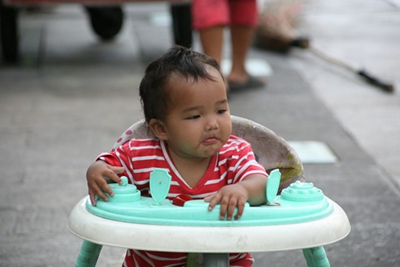
Clear pathways for infants and toddlers allow them to move easily through the room while also creating a defined space for protected exploration. The furnishings and equipment should allow a variety of movement choices so infants can crawl through, pull up on and, as they develop physical skills, climb on and jump off.[3]
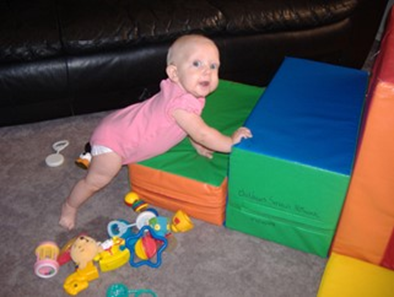
Soft, thick floor coverings, such as vinyl mats, help mobile infants feel comfortable moving on the floor.
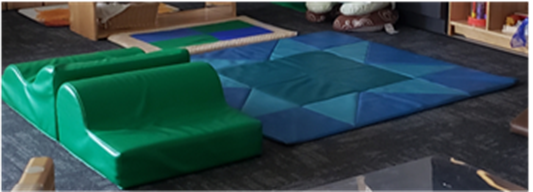
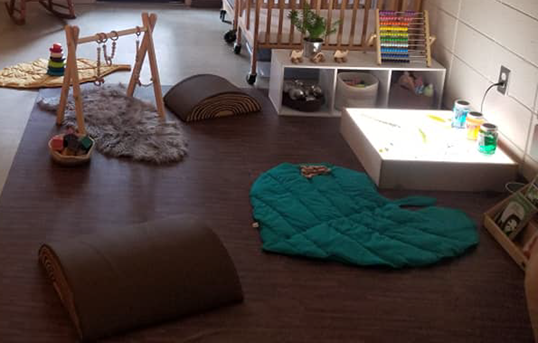
Adding unique and exciting features such as tunnels encourages further motor skills and exploration development.
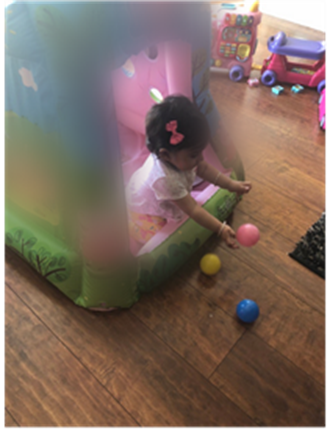
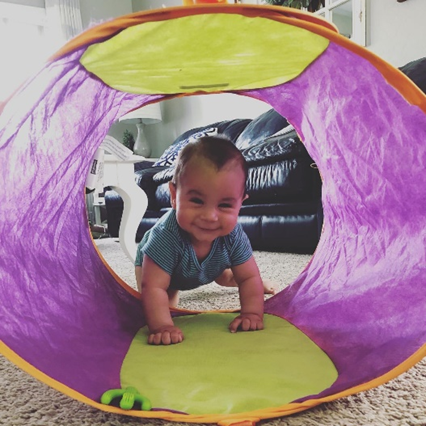
For toddlers, slopes, stairs, or small ladders allow the opportunity for safe vertical movement. Offering infants and toddlers a variety of choices throughout the day helps them stay safely interested and engaged.[8]
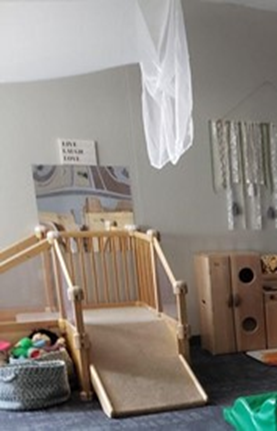
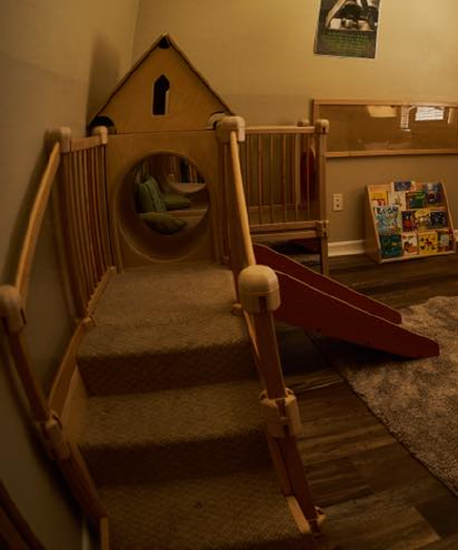
A positive environment allows children to move freely without hearing "no" as they explore, make choices and interact with their surroundings.[10] Young children can follow their interests and develop their abilities within an environment that is respectful and encouraging of them.[1] When children feel supported and engaged in an “environment of yes”, they are less likely to exhibit behaviors that are challenging to adults.[11]
For infants and toddlers, every aspect of the world is exciting and engaging. Environments should support them in discovering that they can find and use materials independently. When infants and toddlers spend their days in a well-organized environment with clear choices, they find fascinating materials and can concentrate their efforts on exploring and learning. Storing materials on low, open shelves lets children see the materials available, make a choice, and return the item with less adult support. As soon as children can creep or crawl to materials, they should be encouraged to select and access the materials they are interested in playing with on their own. (The Ohio State University for the US Department of Defense’s Office of Family Policy/Children and Youth, 2021) A disorganized or overstimulating environment creates difficulty for infants and toddlers to focus on a particular environmental aspect. Too many options can be overwhelming.
Arrange the environment so that infants and toddlers can concentrate on the things that interest them. Creating a space that protects young infants from the movement of older children allows exploration with confidence. Well-defined areas protected from traffic patterns let toddlers play without interruption. It is also essential to consider ways to provide appropriate risk-taking opportunities as young children seek out challenges as they grow and learn.[1]
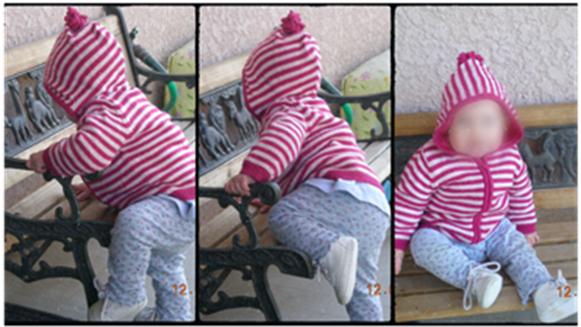
When children learn to use signs and symbols in their environment it promotes independence. Caregivers support independence by carefully labeling objects and the places where things belong. The best labels use written words plus pictures or parts of the object (like a puzzle piece on a shelf that contains wooden puzzles). Labeling not only helps children learn to access toys and eventually clean up independently, but it also creates a print-rich environment. Caregivers discover they give fewer directions and reminders when appropriate labels are used. When children can engage independently with materials, caregivers have more time for interacting and expanding learning opportunities.
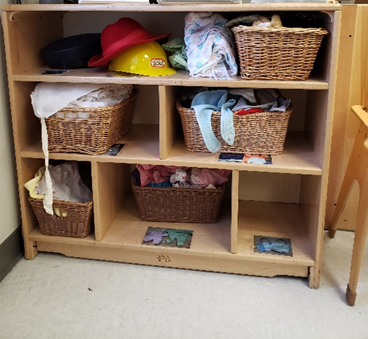
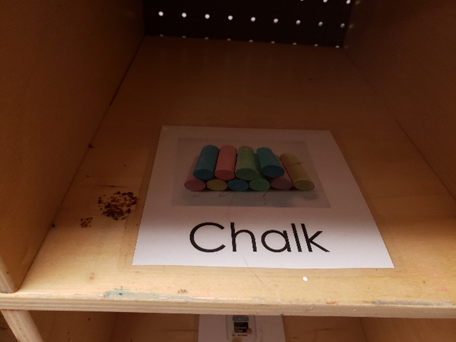
[1] California Department of Education. (2019). Infant/Toddler Learning and Development Program Guidelines, Second Edition. Sacramento: California Department of Education. Is used with permission.
[2] Image by Paul Ma from Pixabay
[3] Office of Head Start and Office of the Administration for Children and Families. (n.d.). Health and Safety Screener: is in the public domain
[4] Image by Amanda Taintor is licensed CC BY-NC
[5] Young infant environment by Chantel Hunter with Turning Sun isi used with permission.
[6] Image by Gurpreet Bhogal is licensed CC: BY-NC
[7] Image by Molly Ram is licensed CC: BY-NC
[8] U.S. Department of Health & Human Services: Administration for Children and Families. ECLKC Nurturing Environments. is in the public domain.
[9] Image by Green Tree Community School, LLC is used with permission.
[10] The California Infant/Toddler Curriculum Framework by the California Department of Education is used with permission (2012)
[11] U.S Department of Health and Human Services: Administration for Children and Families. Responsive Learning Environments. ECLKC. Is in the public domain.

